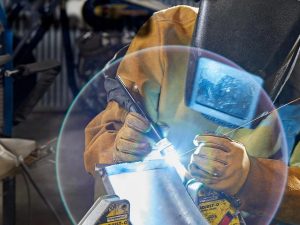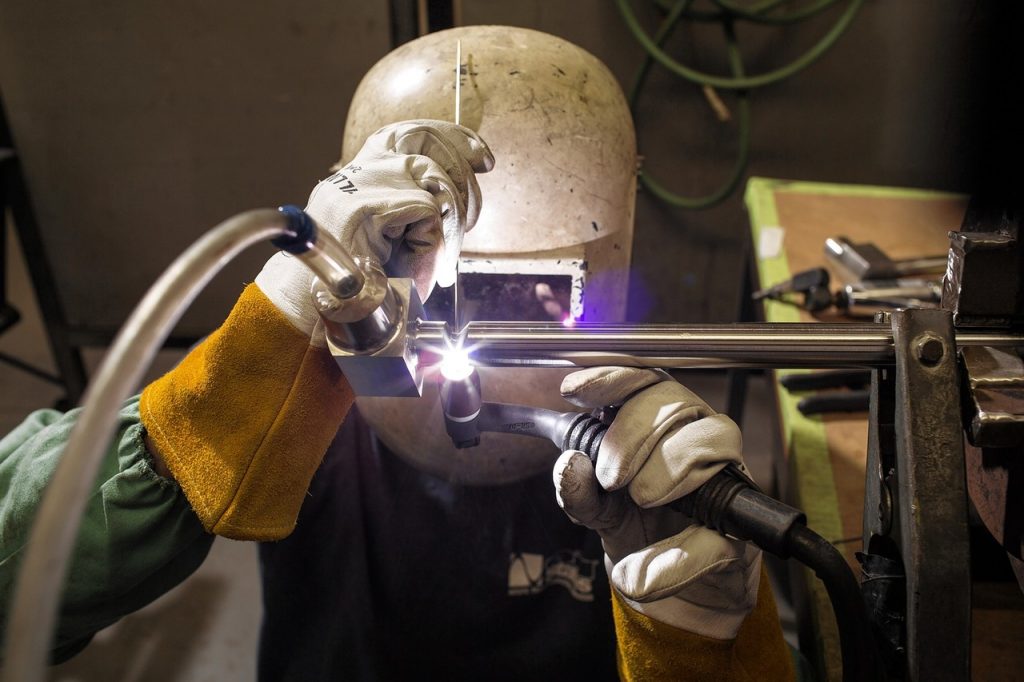In the industry, there are several welding processes. These include TIG – Gas Tungsten Arc Welding GTAW; Flux-Cored Arc Welding FCAW; Stick – Shielded-Metal Arc Welding SMAW; and MIG – Gas Metal Arc Welding GMAW. Each of these welding processes has unique advantages and disadvantages.
TIG – Gas Tungsten Arc Welding GTAW
GTAW is a common welding process that uses a tungsten electrode. Tungsten is a non-consumable metal that has a melting point greater than 790°C, making it an ideal material for this type of welding. GTAW electrodes can range in diameter from 0.5 to 6.4 mm.
GTAW welding can be performed with various power sources. One type of GTAW uses a DC pulsed power source, which is usually proprietary. This type of welding process has several benefits, including lower heat input and increased speed. It can be used for a variety of applications, including cladding and automatic girth welders.
GTAW is more expensive than MIG or stick welding, but it produces higher quality welds and a higher level of safety. GTAW welders can weld thicker workpieces, such as stainless steel.
Flux-Cored Arc Welding FCAW
When compared to other arc welding methods, FCAW has certain distinct advantages. For instance, it does not require an additional shielding gas tank, produces less smoke, and can be used in the outdoors. It also requires a well-ventilated working environment. It is also the most flexible of all welding methods, offering a wide range of configurations and materials. In addition, FCAW produces the least amount of slag and spatter.
The main difference between FCAW and GMAW lies in the process of filling the arc with the filler metal. In FCAW, the filler metal is deposited across the arc, rather than being melted by the arc. The filler metal transfer is a continuous process, which means that it is not a one-time process like GMAW. Additionally, FCAW can be performed with a single pass, while GMAW requires several passes. This leads to a less distorted weld.
Flux-cored arc welding can be done with air-cooled or water-cooled guns. The water flow helps reduce the temperatures. In addition, the flux-cored arc welding process is highly automated, and robots can perform the welding process.
Stick – Shielded-Metal Arc Welding SMAW
Shielded-Metal Arc welding (SMAW) is a process that welds metals together using an alternating current. The process utilizes a metal rod with a flux-coated electrode. The metal rod is placed in an electrode holder and connected to a power source. The electrode and work piece are placed in close proximity, and an arc is created between the two. This creates a heat that melts the metal together, creating a solid weld.
Shielded-Metal Arc welding is a versatile, cheap, and relatively easy process. The process is flexible and can be used in tough environments, such as underwater. It can also weld materials that are dirty or corrosive. In addition, shielded-metal arc welding is cheap, easy to learn, and can produce high-quality welds.
When choosing an electrode, you should know that the electrodes used for SMAW welding are designed to use either AC or DC power sources. In some cases, it is possible to use one with the other, but it is important to check the compatibility of the electrodes and the power source before choosing one.

MIG – Gas Metal Arc Welding GMAW
Gas Metal Arc Welding is a type of arc welding that uses a wire electrode to fuse metal materials together. The wire electrode is fed with a current by a welder who presses a trigger to apply the current to the workpiece. Shielding gas is then sprayed onto the workpiece to protect it from the arc and the surrounding air.
MIG welding can be used to join thin or thick metal plates. The electrodes used are available in sizes ranging from 0.6 to 2.4 mm. They come in a variety of materials and are usually supplied on a reel. The electrodes are coated with copper and are positioned at or near the contact tip.
Gas selection is critical for GMAW. Shielding gas will have a number of effects on the welding process, including arc stability, metal transfer, and weld pool behavior. General purpose shielding gases includes argon, oxygen, and CO2, while more specialized gas mixtures may contain helium.
Laser Beam Welding
Laser beam welding is one of the many welding processes that uses a concentrated light source to join two metal parts. The laser is powered by a high-voltage power source and is aimed at the workpiece. It uses a lens to focus the beam. This process is controlled by a computer known as a CAM. The laser speed and the speed of the workpiece table are controlled by the CAM.
The laser source produces a beam that has many essential properties. One of these properties is its brightness, measured in power per unit surface area per unit solid angle. Another important property is its power mode, which determines the shape of the weld bead. A high beam power mode results in a larger width-to-depth ratio. Beam stability is also important for the quality of the weld. Finally, beam polarization is an important characteristic because it provides direction identification. A laser beam will be most effective if it can be aimed at the same direction as the material being welded.
Laser beam welding can be done using both pulsed and continuous wave lasers. Pulsed lasers produce a pulsed pattern of light while continuous-wave lasers produce a continuous laser beam. A continuous-wave laser can produce a narrow spot weld, while a pulsed laser will produce a wider area.
Electron-Beam Welding
Electron-Beam welding is one of the many different types of welding processes. It is a very effective method of joining metal components. The high power density of the beam instantly volatilizes the metal and creates a needle-like vapor-filled cavity that allows the beam to penetrate the workpiece. This vapor-filled cavity keeps the welding area open during the process, and the molten metal flows from the front to the rear of the keyhole during the welding process.
In order to perform a high-quality weld, the electron beam must be focused on the workpiece. The focus is determined by a number of parameters, including the working distance and the accelerating voltage. The amount of heat input is also dependent on the beam’s diameter and travel speed. Higher beam current increases the heat input, and lower beam speed decreases it. To optimize the process, the focus of the beam may be moved relative to the workpiece. In this way, the depth of penetration is increased and the width of the weld increased.
The energy required by electron beam welding depends on the physical properties of the material. The lower the surface power density, the more favorable the weld. In some cases, the lower the surface power density, the more energy is needed. Higher surface power density can lead to total material evaporation, which is not desirable for welding.
Welding Equipment
Welding is a process that fuses metals together, and there are a variety of processes to choose from. Some of them are metal-on-metal (M2M) and some are plastic-on-metal (P2M). Regardless of the type of welding process, the safety measures are the same.
Gas metal arc welding is one of the oldest welding processes and is arguably the easiest to use. It also uses little energy and is often considered the most economical. This type of welding is also considered to be easier to master, although it does require a lot of practice to perfect. It is also better suited for thin, non-ferrous materials.
Gas-free welding is another type of process. Flux-core welding involves using a metal-conductive wire instead of a shielded gas to create a weld. The process is usually done outdoors and does not require a shielding gas. This method is often used in the repair of heavy equipment. The disadvantage is that the slag from the metal melted will need to be cleaned up.
Welding Tips
There are many types of welding processes, each one requiring a different set of skills and knowledge. To choose the right process, you must first determine what type of metal you’re planning on welding. While some people think that the most basic and straightforward type of welding is TIG, the truth is that there are other methods that can produce the same results.
Having the correct equipment and safety measures for the welding process is crucial. The materials and equipment you use should not only be suitable for the job, but also comfortable. This will not only contribute to the safety of the welder, but it will also improve the quality of the finished weld.
Before welding, make sure that the electrode has the proper polarity. In MIG welding, you should make sure that the electrode is positive, and then reverse it. Also, make sure that the shielding gas is at least 20 to 25 cubic feet per hour. Another important tip for MIG welding is to clean the contact tips. Using a soapy water solution will help you detect if there’s a leak in the gas hose. If you find a leak, replace it with a new one.

